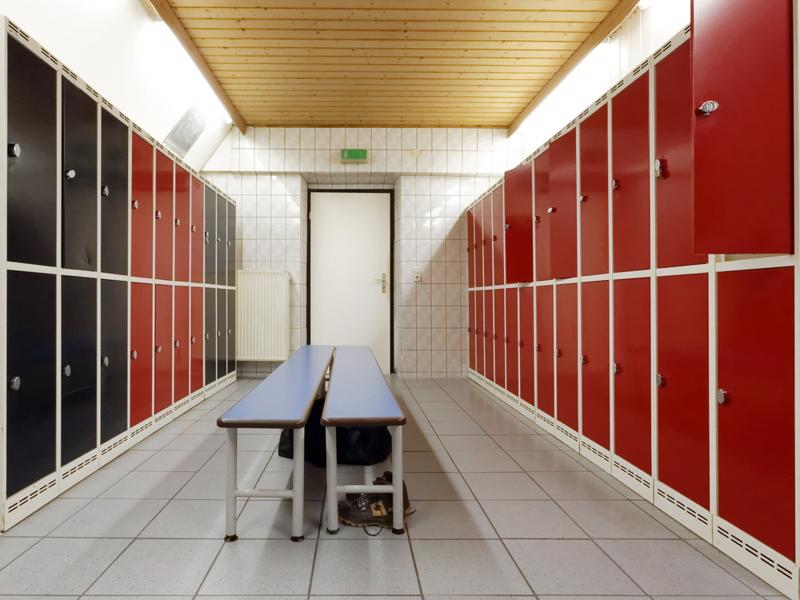Powerful air ventilation systems can reduce the amount of bacteria found in a locker room.
Building managers overseeing locker rooms in gyms and stadiums will need to ensure these areas are outfitted with working air filtration systems. Whether it’s the men’s or women’s area, locker rooms may foster the harmful growth of infectious diseases and more if they are not properly cleaned, or don’t have a functioning HVAC system.
Filter Out the Odors
Locker rooms are typically used by gym goers and professional athletes for a variety of reasons, and it’s not uncommon to sometimes think of locker rooms as where athletes hang out. In fact, these facilities serve many purposes, starting with as a private area for individuals to change and shower in.
But as sports have changed to become an even bigger part of popular culture, professional teams have invested more into their facilities. These days, locker rooms are only one part of a much larger facility. Take for instance the Oregon Ducks college football team, who in 2013 unveiled a $68 million dollar structure where student-athletes could realistically live in.
Athletes have access to not only a cafeteria, barbershop and theater, but also a weight room, health center and changing area. No matter the time of the year, athletes are training to better themselves for the next season. While the sweat or odors inherent in any locker room setting may not seem like much at face value, if perspiration and such aren’t accounted for, health issues can arise.
By removing odors, building managers are creating a cleaner environment that not only looks well kept, but also smells pleasant, given the purpose these areas serve. Locker rooms in public gyms or workout spots may be avoided if they are not properly maintained, and this could translate into members foregoing storing their personal belongings in a locker. This may increase the risk of potential theft.
But in locker rooms, a more dangerous situation has the potential to cause serious medical harm in the form of staph infections and potentially MRSA.

What is a Staph Infection?
As defined by the Mayo Clinic, staph infections can be caused by staphylococcus bacteria making its way deep into an individual’s body, such as the bloodstream or heart. Staph infection symptoms are varied depending on where the infection is first found.
For example, skin infection symptoms include the development of boils, a painful impetigo or even scalded skin syndrome, which is when blisters form and easily break.
In sports, staph infections can spread through contact when there are open cuts or skin-to-skin contact. Locker rooms are also known to be a cause for these infections when athletes share equipment, towels or uniforms.
One serious form of a staph infection is MRSA, which the Mayo Clinic stated is typically resistant to major antibiotics used to treat regular staph infections. MRSA can also be spread by skin-to-skin contact in locker rooms.
MRSA infections are not just a concern at the high school or amateur level, either. In 2015, former Tampa Bay Buccaneers kicker Lawrence Tynes sued the team after he contracted MRSA that forced him to retire. He claimed the organization never informed the team members that individuals who had MRSA visited facilities, nor was equipment properly cleaned and sterilized.
The infection also affected former New York Giants player Daniel Fells, who, as of December 2015, underwent 10 surgeries to treat MRSA, according to USA Today.
These are only a small number of professional athletes who have developed MRSA and as such, organizations and building managers need to ensure their athletes are in the safest locker room environment possible.
“Powerful air ventilation systems can reduce the amount of bacteria found in a locker room.”
Creating a Clean Locker Room
First, all gym and locker room equipment should be thoroughly cleaned and sterilized to help prevent staph infections from spreading. Athletes will also have to be proactive to prevent contracting these serious infections. The U.S. Centers for Disease Control and Prevention recommended athletes always wash their hands before and after playing or practicing their sport. By following good personal hygiene, athletes of all ages will help decrease the chance of contracting a staph infection or MRSA.
But the locker rooms also need to be outfitted with the latest in air filtration systems. The Mayo Clinic stated that staph bacteria is found in the nose or on the skin of roughly a third of the population and in most instances, the bacteria is harmless.
Even so, powerful air ventilation systems can help reduce the amount of bacteria found in a locker room, while also eliminating odors and mildew. These systems should be utilized everywhere, from high school and college locker rooms to those found in public gyms and workout facilities.
By contacting Air Impurities Removal Systems, locker room and building managers are helping to ensure they are doing everything possible to reduce the likelihood of athletes contacting a serious infection.











Eliminate Harmful Locker Room Bacteria With Clean Air Systems